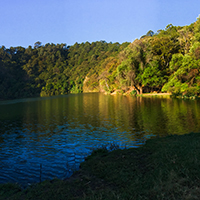Seasonal variation of Microcystis aeruginosa and factors related to blooms in a deep warm monomictic lake in Mexico

Accepted: 23 April 2021
Supplementary: 91
HTML: 21
All claims expressed in this article are solely those of the authors and do not necessarily represent those of their affiliated organizations, or those of the publisher, the editors and the reviewers. Any product that may be evaluated in this article or claim that may be made by its manufacturer is not guaranteed or endorsed by the publisher.
Authors
The occurrence of cyanobacterial blooms has increased globally over the last decades, with the combined effect of climate change and eutrophication as its main drivers. The seasonal dynamic of cyanobacterial blooms is a well-known phenomenon in lakes and reservoirs in temperate zones. Nevertheless, in the tropics, most studies have been performed in shallow and artificial lakes; therefore, the seasonal dynamic of cyanobacterial blooms in deep and eutrophic tropical lakes is still under research. We studied the seasonal variation of the phytoplankton community and the factors associated with Microcystis aeruginosa blooms along the water column of Lake Alberca de Tacámbaro, a warm monomictic crater lake located in Mexico, during 2018 and 2019. According to previous studies performed in 2006 and 2010, this lake was mesotrophic-eutrophic, with Chlorophyta and Bacillariophyta as the dominant groups of the phytoplankton community. During 2018 and 2019, the lake was eutrophic and occasionally, hypertrophic, a phenomenon likely associated with the increase of farmland area around the lake. The dominant species was M. aeruginosa, forming blooms from the surface to 10 m depth in winter, in the hypolimnion in spring and summer, and along the full water column in autumn. These findings suggest that M. aeruginosa in Lake Alberca de Tacámbaro displays seasonal and spatial population dynamics. Total phosphorus, dissolved inorganic nitrogen, water temperature and photosynthetically active radiation were the environmental factors related to M. aeruginosa blooms. Our results suggest that the changes in the structure of the phytoplankton community through time, and M. aeruginosa blooms in Lake Alberca de Tacámbaro, are mainly related to changes in land use from forest to farmland in areas adjacent to the lake, which promoted its eutrophication in the last years through runoffs. Comparative studies with other deep and eutrophic lakes will allow us to gain a deeper understanding of the dynamic of cyanobacterial blooms in natural and artificial water reservoirs strongly stressed by human activities.
Edited by
Diego Fontaneto, CNR-IRSA Water Research Institute, Verbania, ItalyHow to Cite

This work is licensed under a Creative Commons Attribution-NonCommercial 4.0 International License.
Similar Articles
- Brian A. Whitton, Acidic pit lakes - The legacy of coal and metal surface mines , Journal of Limnology: Vol. 72 No. 1 (2013)
- Włodzimierz Marszelewski, Bożena Pius, Effect of climate change on thermal-ice regime of shallow lakes compared to deep lakes: Case study of lakes in the temperate zone (Northern Poland) , Journal of Limnology: Vol. 78 No. 1 (2019)
- Benedetta PONTI, Roberta PISCIA, Roberta BETTINETTI, Marina MANCA, Long-term adaptation of Daphnia to toxic environment in Lake Orta: the effects of short-term exposure to copper and acidification , Journal of Limnology: Vol. 69 No. 2 (2010)
- Lluís CAMARERO, Richard F. WRIGHT, Jordi CATALAN, Marc VENTURA, Application of MAGIC to Lake Redó (Central Pyrenees): an assessment of the effects of possible climate driven changes in atmospheric precipitation, base cation deposition, and weathering rates on lake water chemistry , Journal of Limnology: Vol. 63 No. 1 (2004)
- Marina MANCA, Patrizia COMOLI, Valeria LENCIONI, Population dynamics and production of crustacean zooplankton in two mountain lakes in the Italian Alps (Lake Paione Superiore and Lake Malghette). , Journal of Limnology: Vol. 58 No. 1 (1999)
- Barbara Fiasca, Fabio Stoch, Marie-Josè Olivier, Chafik Maazouzi, Marco Petitta, Alessia Di Cioccio, Diana M.P. Galassi, The dark side of springs: what drives small-scale spatial patterns of subsurface meiofaunal assemblages? , Journal of Limnology: Vol. 73 No. 1 (2014)
- Marcela BASTIDAS NAVARRO, Beatriz MODENUTTI, UVR induce optical changes and phosphorous release of lake water and macrophyte leachates in shallow Andean lakes , Journal of Limnology: Vol. 69 No. 1 (2010)
- David G. Jenkins, Lakes and rivers as microcosms, version 2.0 , Journal of Limnology: Vol. 73 No. s1 (2014): Limnology in the 21st Century: celebrating 75 years of ecological research in Pallanza
- Krzysztof Pleskot, Mónika Tóth, Karina Apolinarska, Distribution of subfossil chironomids (Diptera, Chironomidae) along a water depth gradient in the shallow Lake Spore, northern Poland , Journal of Limnology: Vol. 78 No. 3 (2019)
- Carla BONACINA, Renato BAUDO, Lake Orta: a case study (Part 1) , Journal of Limnology: Vol. 60 No. 1 (2001)
<< < 46 47 48 49 50 51 52 53 54 55 > >>
You may also start an advanced similarity search for this article.
-
Richard Mugani, Fatima El Khalloufi, Minoru Kasada, El Mahdi Redouane, Mohammed Haida, Roseline Prisca Aba, Yasser Essadki, Soukaina El Amrani Zerrifi, Sven-Oliver Herter, Abdessamad Hejjaj, Faissal Aziz, Naaila Ouazzani, Joana Azevedo, Alexandre Campos, Anke Putschew, Hans-Peter Grossart, Laila Mandi, Vitor Vasconcelos, Brahim OudraHarmful Algae : 2024
-
Gerardo Ávila-Torres, Gabriela Rosiles-González, Victor Hugo Carrillo-Jovel, Gilberto Acosta-González, Eduardo Cejudo-Espinosa, Daniela Ortega-Camacho, Cecilia Hernández-Zepeda, Oscar Alberto Moreno ValenzuelaMicrobiology Research : 2023
-
Daisy Valera Fernández, Beatriz Ortega Guerrero, Elizabeth Solleiro Rebolledo, Cecilia Irene Caballero MirandaGeofísica Internacional : 2024

 https://doi.org/10.4081/jlimnol.2021.2013
https://doi.org/10.4081/jlimnol.2021.2013





